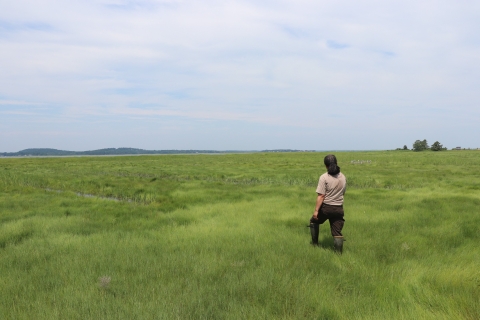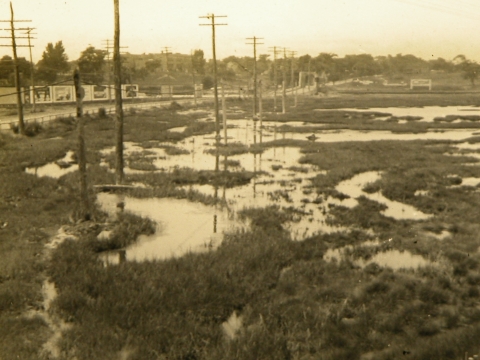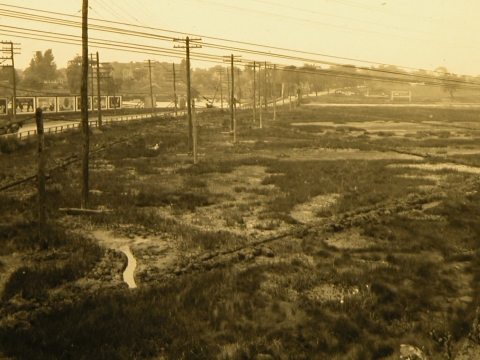One by one, academic salt marsh salt marsh
Salt marshes are found in tidal areas near the coast, where freshwater mixes with saltwater.
Learn more about salt marsh ecologists and federal biologists started voicing concerns that the Great Marsh was in trouble. “Some of us noticed vegetation dying back, others saw big pools of standing water,” said Nancy Pau, U.S. Fish and Wildlife Service biologist at Parker River National Wildlife Refuge in Massachusetts.
The Great Marsh stretches from Cape Ann, Massachusetts, to the southeastern coast of New Hampshire with over 20,000 acres of mud flats, islands, beaches, and salt marshes. These incredibly dynamic habitats form a buffer between the land and the sea where flooding is frequent due to the natural ebb and flow of the tides.
According to Pau, it wasn’t until 2015 during a Great Marsh workshop that a bigger picture began to emerge. Mega pools were forming across salt marshes in the northeastern U.S., resulting from agricultural remnants from the 1600s and collapsed mosquito control ditches from the 1900s. There was evidence of subsidence and erosion while marsh vegetation was dying back.
“Every year that the salt marsh is not in vegetation, we lose elevation” said Susan Adamowicz, Rachel Carson National Wildlife Refuge’s Land Management and Research Demonstration biologist. Elevation is key as it maintains the marsh as a raised bed of vegetation. Without elevation, marshes convert to open water or mud flats.
A visitor to the Great Marsh today would see a vast expanse of dense green grasses, essentially a coastal grassland. Weaving in and out would be ribbons of water that turn to mud as the tide recedes. Looking across the landscape, the visitor might see a subtle line where one section of grass meets another or a pool of water that stays behind when the tide recedes. These faint lines and small standing pools may represent scars from farming or mosquito control. Incredibly subtle, these alterations appear perfectly natural and healthy to the untrained eye.
The man-made changes to salt marshes were far more intrusive than biologists initially realized. “Alterations don’t appear large today,” Adamowicz said. “That’s the kicker. We’ve been walking these marshes for decades and never seeing what was right beneath our noses.” And yet these subtle changes have dramatic effects on the ecosystem and how it functions.
Acting as buffers against flooding and storm surge, salt marshes make coastlines more resilient against erosion, sea level rise and climate change climate change
Climate change includes both global warming driven by human-induced emissions of greenhouse gases and the resulting large-scale shifts in weather patterns. Though there have been previous periods of climatic change, since the mid-20th century humans have had an unprecedented impact on Earth's climate system and caused change on a global scale.
Learn more about climate change . They provide habitat for many high-priority species such as saltmarsh sparrow and serve as a nursery for many seafood species such as crabs, shrimp and mussels. A healthy marsh is dominated by grasses such as smooth cordgrass (Spartina alterniflora) and can be divided into high and low marsh sections. Unlike low marsh grasses which flood twice daily, high marsh grasses flood infrequently and provide critical habitat for many species.
Humans have a history of altering marsh hydrology for purposes like farming or mosquito control, and unfortunately those practices leave scars. Serious salt marsh alteration began in the 1600s when early colonial settlers used marshes for cattle grazing and farm land, harvesting huge stacks of salt marsh hay for livestock feed and bedding. To increase hay yield, farmers built embankments to prevent flooding and irrigation ditches to drain water. These practices were systematically applied from Maine to the Carolinas as farmers altered marshes along the Atlantic Coast.
In the face of rising tides and climate change, conservation partners are working hard to retain marsh elevation and turn back the clock to pre-colonial conditions. Along with The Trustees of Reservations, Massachusetts Division of Fisheries and Wildlife, the University of New Hampshire, and Geoff Wilson with Northeast Wetland Restoration, Adamowicz has been involved with salt marsh restoration at Old Town Hill Reserve in Newbury, Massachusetts, since 2019. The site suffers from remnants of colonial farming reaching back more than 300 years: a grand total of 219 irrigation ditches and 51 embankments. The ditches, placed at twice the density of natural creeks, would have kept the marsh well drained and increased salt hay yield by 200–300 percent.
While effective for increasing hay yield in the 1600s, the ditches have adversely altered current day salt marsh hydrology. Some of these old irrigation ditches have clogged leading to pool formation and soaked marsh areas where peat decomposes, elevation erodes and valuable high marsh habitat dies back. Still functioning ditches drain water from the marsh, producing areas that are too dry, causing peat to subside.
In many areas across the Northeast and mid-Atlantic Coast, old irrigation scars have been layered with mosquito control ditching. According to Roger Wolfe, mosquito management coordinator with Connecticut’s Department of Energy and Environmental Protection, mosquito ditching took place from the 1930s through the 1970s. Ninety percent of coastal wetlands from Maine to Virginia were impacted by mosquito ditching by 1950 (Bourn and Cottom, 1950). Large-scale efforts established by the Civilian Conservation Corps employed many people during the Depression. Mosquito ditching aimed to curb the widespread use of chemical insecticide and prevent mosquitoes from laying eggs by draining the marshes of standing water.
The ditches, only moderately effective as a mosquito control technique as stated by Wolfe, replaced creek hydrology with ditch draining, leading to marsh drying and subsidence. This practice was commonplace until the passing of the Tidal Wetlands Act in 1973.
In many states, modern salt marsh mosquito control uses a holistic approach to wetland management called integrated marsh management that includes mosquito control, invasive plant management, habitat enhancement, hydrologic modification and education.
As in modern mosquito control, the first goal of modern salt marsh management is to restore tidal hydrology and to keep marshes from drying out or giving way to standing water. A healthy marsh with proper vegetation and hydrology acts like a sponge by expanding and contracting which makes the marsh more resilient against both flooding and drying.
To fix hydrology at Old Town Hill in Massachusetts, 50 percent of the old agricultural ditches are being restored to marsh vegetation. “We’re not filling ditches… not in the way most people understand,” said Adamowicz, “We’re using natural materials and processes to create peat in the ditch and heal it from the bottom up.”
Mowers and hay rakes are used to knit existing vegetation together in the ditches, healing them slowly over the course of years. Adamowicz works collaboratively with many partners and employs a four-tiered approach to restoration known as HOTT:
- Halt Subsidence by fixing salt marsh hydrology
- Optimize Accretion by building back elevation
- Tune for Wildlife by restoring habitat for tidal dependent species
- Tend to Your Marsh by planning for long-term conservation and adaptive management
HOTT is being carried out by many partners working collaboratively on Salt Marsh Adaptation & Resiliency Teams (SMARTeams) to address restoration on a larger scale. SMARTeams incorporate technical support, education and training by working with multiple agencies including the Natural Resources Conservation Service (NRCS), the National Oceanic and Atmospheric Administration (NOAA) and Audubon among others. SMARTeams aim to restore natural salt marsh functions, gain marsh elevation and habitat, and make salt marshes more resilient.
The geographic scope of embankments and ditching on East Coast salt marshes have proved to be far more widespread than initially perceived. These man-made scars, easily seen by taking a tour on Google Earth, have altered salt marsh hydrology since the colonial era. Working against climate change and sea level rise, stewards like Adamowicz and Pau are building a better salt marsh, and salt marsh legacy, for hundreds of years to come.







